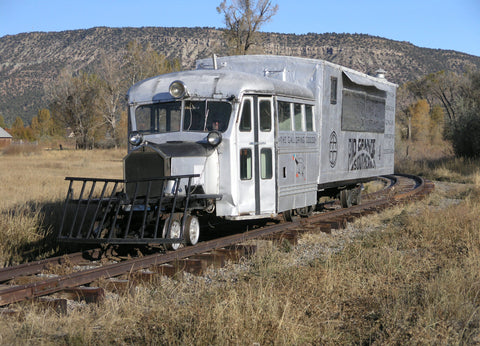
Tracking the History of Mile-High Railroads
Ridgway, a town of just over 1,000 souls along the Uncompahgre River in southwest Colorado’s San Juan Mountains, is rooted in railroad history. The townsite was established in 1890 by business partners Otto Mears and Fred Walsen at the northern terminus of Mears’ Rio Grande Southern Railroad (incorporated in 1889), where it met the existing Ouray Branch of the Denver & Rio Grande Railway (later Denver & Rio Grande Western Railroad). The Rio Grande Southern ran from Durango to Ridgway, which was named for Robert M. Ridgway, the construction superintendent of the new railroad. As the birthplace of the RGS, the town was the natural site for the Ridgway Railroad Museum.
Russian immigrant Otto Mears, who turned some of his toll roads into narrow- gauge railroad beds and became known as the “Pathfinder of the San Juans,” built the 21.5-mile Silverton Railroad, from Silverton to the mines up in Red Mountain Pass, in 1887–89. He followed that up by building the Rio Grande Southern to transport silver produced by the mining communities of Ouray, Telluride, Ophir and Rico, as well as coal from Porter to the smelter in Durango. The RGS railbed was an engineering marvel, at 162 miles long with more than 140 high trestles and bridges and such unusual features as the celebrated Ophir Loop. Alas, the instant success of Mears’ railroads didn’t last long, due to the Panic of 1893. The resulting national depression shuttered most silver mines out West. The Silverton Railroad made almost no money after silver prices dropped and mines closed, and the line was dismantled in 1926. The RGS hung on and continued to operate through 1951, partly due to the success of a fleet of unique automobile-based railcars known as “Galloping Geese.” Nearly a half century later, in 1998, the Ridgway Railroad Museum was born with the mission to explain and interpret the role and significance of railroads in the region.
Fashioned around a Model T Ford engine and
transmission, the replica inspection car takes visitors on a spin around the
half-mile loop track.
In its rail yard the nonprofit, all-volunteer museum displays a dozen restored or re-created railcars from the heyday of the RGS and D&RG. Every Saturday between May and October visitors are treated to rides on a half-mile loop track aboard RGS Motor 1, a prototype for the Galloping Geese. Among the painstakingly restored cars is D&RGW Caboose No. 0575. Be sure not to miss the re-created RGS inspection car originally built in 1913 out of a 1910 Model T Ford and destroyed in a 1925 wreck. This working copy captures its full glory.
Passenger coach No. 252 was built for the D&RG in 1880 and sold to the RGS in 1891. It carried 48 passengers in flip-over “Buntin” seats and offered the luxuries of a restroom and two coal-burning stoves for heat. It is the only fully restored RGS coach in existence, with period-correct seats, white ash interior panels and a gas chandelier.
The
restored interior of RGS passenger coach No. 252 includes period correct seats
and a gas chandelier.
Perhaps the most interesting railcar is one of the aforementioned 1930s fleet of seven Galloping Geese, which were built around automobile bodies and used to carry the mail, light freight and a handful of passengers. Galloping Goose No. 4 (on part-time display at the museum between September and late May) underwent four years of restoration in Ridgway before being put to the test. “We ran it for four days on the Durango & Silverton Narrow Gauge Railroad as part of its Railfest event in 2015,” says Jim Pettengill, vice president of the Ridgway Railroad Museum board. “It was the first time it had carried passengers through these mountains in 64 years. It belongs to the Telluride Fire Department, and they display it in the summer, then we store it here under cover in the fall and winter, using it for rides in May, September and October of each year.”
A
diorama captures Ridgway’s busy rail yard and depot circa 1948.
Be sure to check out the historic D&RGW depot building. Among other exhibits are a diorama of the circa 1948 Ridgway rail yard, a rare Otto Mears silver filigree railroad pass, models of railcars that once operated in the region and a passel of period photos. The depot also houses the Ouray County Ranch History Museum, which plans to move into its own building, allowing the Ridgway Railroad Museum to greatly expand its exhibits. An extensive research library, which preserves hundreds of books and more than 250,000 pages of RGS company documents, is off-site, though some archival material is available on the museum website. Railroad aficionados can also pick up fact-filled books published by the museum, namely The History and Restoration of Galloping Goose No. 4 and Narrow Gauge Railroading in the San Juan Triangle.
The Ridgway Railroad Museum is at 200 N. Railroad St. Admission and rides are free. For more information visit ridgwayrailroadmuseum.org.
